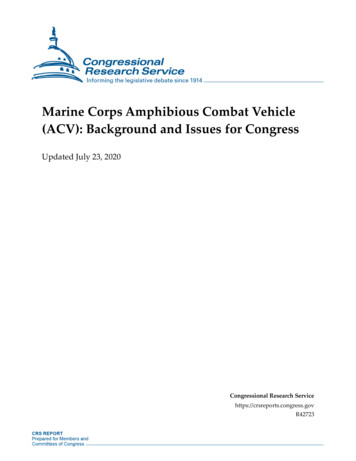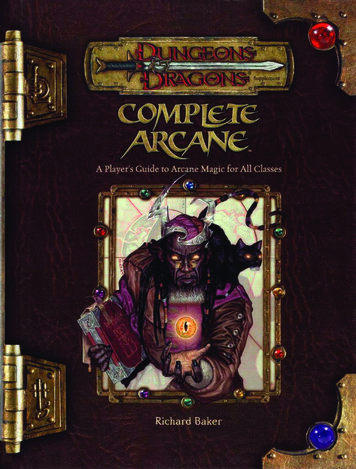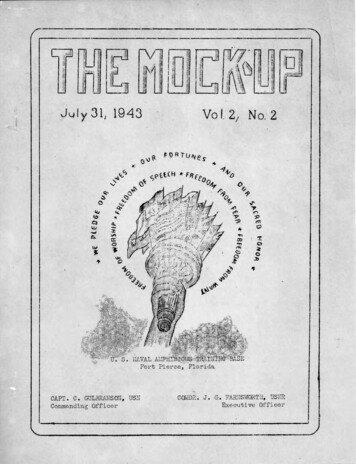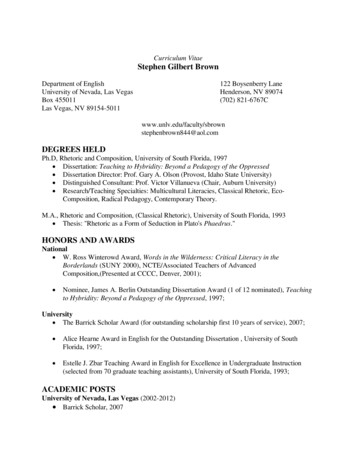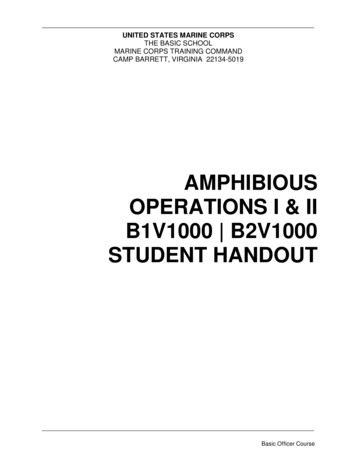
Transcription
UNITED STATES MARINE CORPSTHE BASIC SCHOOLMARINE CORPS TRAINING COMMANDCAMP BARRETT, VIRGINIA 22134-5019AMPHIBIOUSOPERATIONS I & IIB1V1000 B2V1000STUDENT HANDOUTBasic Officer Course
B1V1000 B2V1000Amphibious Operations I & IIIAmphibious OperationsIntroductionThe Marine Corps is an expeditionary intervention force withthe ability to move rapidly on short notice to whereverneeded to accomplish whatever is required. The Corpspossesses a full range of combat capabilities integrated intoa single-service, air-ground combined arms team. Thesequalities make the Marine Corps unique when compared toother United States (US) military services.For over 1000s of years, the Empires have conductedamphibious operations around the world. Many forms ofoperations fit into the category of amphibious andexpeditionary operations, and the Marine Corps is preparedto conduct a variety of these tasks. These operations havebecome synonymous with the term Marine, and the studentofficer needs to understand and be able to operate in thesetypes of missions.ImportanceThe Marine Corps has the ability to project combat powerashore for a wide range of contingencies. Depending onthe nature of the threat, we can field a task organizedcombined arms team, consisting of ground, air, andcombat service support elements under a singlecommander. Ship, aircraft, or a combination of both maydeploy these task forces, called Marine air-ground taskforces (MAGTFs), as an independent force or as part of ajoint task force. The information provided here will helpyou understand amphibious operations, navalcampaigning, fleet organization and the MAGTF as wellas understand the junior officer role in the execution ofthese operations.2Basic Officer Course
B1V1000 B2V1000In This LessonAmphibious Operations I & IIIThis lesson covers the following topics:TopicBackgroundMAGTF Core CompetenciesMAGTF CapabilitiesMAGTF ElementsTypes of MAGTFsLocations of Major Combat OrganizationsExpeditionary OperationsReasons for Conducting Expeditionary OpsCharacteristics of Expeditionary OpsSequence in Projecting Expeditionary ForcesAmphibious OperationsCharacteristics of Amphibious OperationsTypes of Amphibious OperationsPhases of Amphibious OperationsInitiating an Amphibious OperationTerminating an Amphibious OperationTools of Amphibious OperationsSummaryReferencesGlossary of Terms and 1525252Basic Officer Course
B1V1000 B2V1000Amphibious Operations I & IIIAmphibious OperationsTerminal Learning ObjectivesLearning ObjectivesAmphibious Operations I :TBS-MAGTF-1002, Without the aid of resources, identify the locations of major Marineunits, without omitting key components.TBS-MAGTF-1003 Without the aid of resources, describe Marine Air-Ground TaskForce (MAGTF) organizations, without omitting key components.TBS-OFF-2104, Given Marines, an amphibious ship, landing craft, and landing plans,lead a platoon during amphibious operations to accomplish the missionAmphibious Operations II :TBS-OFF-2104, Given Marines, an amphibious ship, landing craft, and landing plans,lead a platoon during amphibious operations to accomplish the mission.TBS-OFF-2104, Given Marines, an amphibious ship, landing craft, and landing plans,lead a platoon during amphibious operations to accomplish the mission.Enabling Learning ObjectivesLearning ObjectivesAmphibious Operations I:TBS-MAGTF-1002a, Without the aid of resources, describe Marine ExpeditionaryForces to include all components.TBS-MAGTF-1002b Without the aid of resources, describe Marine Divisions to includeall components.TBS-MAGTF-1002c Without the aid of resources, describe Marine Air Wings to includeall components.TBS-MAGTF-1002d Without the aid of resources, describe Marine Logistics Groups toinclude all components.TBS-MAGTF-1003a Without the aid of references, describe the Marine Air-Ground TaskForce concept without omission.TBS-MAGTF-1003b Without the aid of references, describe the four elements of a MarineExpeditionary Force (MEF) without omission.TBS-MAGTF-1003c Without the aid of references, describe the four elements of a MarineExpeditionary Brigade (MEB) without omission.4Basic Officer Course
B1V1000 B2V1000Amphibious Operations I & IIITBS-MAGTF-1003d Without the aid of references, describe the four elements of a MarineUnit (MEU) without omission.TBS-OFF-2104a, Without the aid of references, describe Marine Corps amphibiousconcepts without omissionTBS-OFF-2104e. Without the aid of reference, describe the role of the marineExpeditionary Unit in amphibious operations without omission.TBS-OFF-2104m, Without the aid of references, describe the characteristics ofexpeditionary operations without omission.Amphibious Operations II:TBS-OFF-2104a. Without the aid of reference, describe Marine Corps amphibiousconcepts without omission.TBS-OFF-2104b. Without the aid of reference, describe the classes of U.S. Navyamphibious ships without omission.TBS-OFF-2104c. Without the aid of reference, describe the types of landing craftwithout omission.TBS-OFF-2104d. Without the aid of reference, describe the role of the AmphibiousSquadron (PHIBRON) in amphibious operations without omission.TBS-OFF-2104e. Without the aid of reference, describe the role of the marineExpeditionary Unit in amphibious operations without omission.TBS-OFF-2104f. Without the aid of reference, describe the types of amphibiousoperations without omission.TBS-OFF-2104g. Without the aid of reference, describe the phases of an amphibiousoperation without omission.TBS-OFF-2104m. Without the aid of a reference, describe the characteristics ofexpeditionary operations without omission.5Basic Officer Course
B1V1000 B2V1000Amphibious Operations I & IIIBackground“Our unique Service culture has allowed the Marine Corps to “think outside the box” andconfront conventional military wisdom. Following the Great War, many theorists believedthat the Allied experience at Gallipoli had demonstrated the folly of amphibious operationsin the face of “modern” weapons. Our experimentation with amphibious techniques duringthe 1920s and 1930s created key capabilities necessary for success in World War II,allowing the Allies to project military power across vast oceans. Without this pre-warinnovation, wresting the continent of Europe from the Axis and seizing bases on the longroad to Japan would have been much more difficult and costly. Since then, the MarineCorps has continually sought to exploit opportunities and overcome challenges wheredomains converge, leading to our development of close air support doctrine, maritimeprepositioning, and vertical envelopment.In order to execute the Marine Corps strategic security role, the institution embracesenduring characteristics—complemented by an ever evolving set of military capabilitiesthat continue to make the Marine Corps especially relevant in the current and futuresecurity era. These are the Marine Corps’ naval character, our responsiveness tomissions across the range of military missions, and our military professionalism.The integrated and highly tailorable organizational capabilities inherent in our Marine AirGround Task Force (MAGTF) structure enable our critical trans-domain role. Consisting ofcommand, ground combat, aviation, and logistical elements organized as necessary foreach particular situation, the MAGTF supports the adaptability necessary in light of theuncertainty of the operational environment and the full range of military operations wemust expect.Naval Character- Often mischaracterized as land forces, the Marine Corps is actually partof the Naval Service—soldiers from the sea. Fundamentally, this is recognition of the vitalstrategic role the Marine Corps provides in transitioning national combat power andinfluence across the critical maritime, land, and air domain interface. As such, MarineCorps forces are primarily designed to be employed, supported, and sustained at andfrom the sea. Mobility and maneuverability constitute the Naval Service’s primaryoperational attributes, stemming directly from the ability of naval forces to move longdistances quickly and efficiently, and to maneuver within the maritime environment toachieve advantage in relation to an adversary.”Marine Corps Operating ConceptsThird EditionJune 20106Basic Officer Course
B1V1000 B2V1000Amphibious Operations I & IIIMAGTF Core CompetenciesOperations are built on a foundation of six special core competencies. The direct resultof more than two centuries of expeditionary experience, these six core competenciesdefine what Marines do and how they operate. Expeditionary readiness.Combined arms integration.Expeditionary operations.Sea-based operations.Forcible entry from the sea.Reserve Integration.ExpeditionaryReadinessExpeditionary readiness defines an institutional mindsetthat is ready to respond instantaneously to world-widecrises, 365 days a year. To Marines, “ready to respond”means much more than being “ready to go.” First it meansbeing ever ready to win our nation’s first battles. Thisrequires a force that can transition from peacetime tocombat operations at a moment’s notice without criticalreserve augmentation and with certain success. Second, itdemands a force ready to flourish under conditions ofuncertainty. Expeditionary readiness is about being readyto adapt to whatever is “out there,” improvising and findingunconventional solutions to unconventional problems. As aresult, it demands a primary focus on the human dimensionrather than the technological dimension of battle. And third,it means being ever ready to defeat the “opponent afternext” — requiring a relentless commitment to innovationand change.Combined ArmsIntegrationAs specifically demanded by Congress, the nation’s navalcrisis response force must be capable of acting on shortnotice and without immediate support from Army and AirForce warfighting forces. In other words, such a force inreadiness requires an organic, combined arms capability.For over half a century, MAGTFs have trained so that asingle commander directs their ground combat, air combat,and combat service support capabilities. Other servicespractice combined arms operations — MAGTF operationsembody them.7Basic Officer Course
B1V1000 B2V1000Amphibious Operations I & IIIMAGTF Core Competencies (Continued)ExpeditionaryOperationsExpeditionary operations are much more than militaryexpeditions on foreign soil. Like expeditionary readiness,expeditionary operations require a special mindset — onethat is constantly prepared for immediate deploymentoverseas into austere operating environments. As a result,expeditionary operations consider host nation support aluxury and are designed to bring everything necessary toaccomplish the mission — from individual equipment up toand including airfields and hospitals.Sea-based OperationsSea-based operations provide for extraordinary strategicreach and give the nation an enduring means to influenceand shape the evolving international environment. Inaddition, sea-based operations provide units with a largemeasure of inherent force protection. A highly ready,combined arms MAGTF operating from a mobile, protectedsea base provides the National Command Authority (NCA)with unimpeded and politically unencumbered access topotential trouble spots around the world.Forcible Entry from theSeaA key requirement for unilateral action is the ability toproject power ashore in a theater without forward basesand in the face of armed opposition. In the past, forcibleentry from the sea was defined by amphibious assaultsfocused on establishing lodgments on the beach and thenbuilding up combat power for subsequent operations. It isnow defined as an uninterrupted movement of forces fromships located far over the horizon directly against decisiveobjectives.Reserve IntegrationMarine Reserves routinely practice carefully crafted reserveintegration plans to augment or reinforce crisis responsemissions and to add combat power for operations,especially at the high end of the conflict spectrum. Forexample, during Operation Desert Storm, 53 percent of theselected Marine Corps reserve end strength was activated,surpassing any other service reserve componentactivations by more than a factor of two. This degree ofintegration provides the Marine Corps with unprecedentedmission depth, operational flexibility, and sustainability upand down the conflict spectrum.8Basic Officer Course
B1V1000 B2V1000Amphibious Operations I & IIIMAGTF CapabilitiesThe Marine Corps task organizes for operations consistent with its statutory tasking to“ provide forces of combined arms, including aviation ” by forming MAGTFs. TheMAGTF is a balanced air-ground combined arms task organization of Marine Corpsforces under a single commander structured to accomplish a specific mission. It is theMarine Corps’ principal organization for all missions across the range of militaryoperations. It is designed to fight, while having the ability to prevent conflicts andcontrol crises. All MAGTFs are task organized and vary in size and capability accordingto the assigned mission, threat, and battlespace environment. They are specificallytailored for rapid deployment by air or sea and ideally suited for a forward presence role.A MAGTF provides the naval, joint, or multinational commander with a readily availableforce capable of operating as The landing force of an amphibious task organization.A land force in sustained operations ashore.A land force or the landward portion of a naval force conducting militaryoperations other than war such as noncombatant evacuations, humanitarianassistance, disaster relief, or the tactical recovery of an aircraft or aircrew.A forward-deployed force providing a strong deterrence in a crisis area.A force conducting training with allied forces as part of theater engagement plan.CapabilitiesMAGTFs provide joint force commanders with the capabilityto: Move forces into crisis areas without revealing theirexact destinations or intentions.Provide continuous presence in international waters.Provide immediate national response in support ofhumanitarian and natural disaster relief operations.Provide credible combat power in a non-provocativeposture, just over the horizon of a potential adversary,for rapid employment as the initial response to acrisis.Support diplomatic processes for peaceful crisisresolution before employing immediately responsivecombat forces.Project measured degrees of combat power ashore,day or night, and under adverse weather conditions, ifrequired.Operate independent of established airfields, basingagreements, and overflight rights.Sequentially introduce additional forces into a theaterof operations.9Basic Officer Course
B1V1000 B2V1000Amphibious Operations I & IIIMAGTF Capabilities (Continued)Capabilities (Continued) Conduct operations ashore using organic combatservice support brought into the area of operations.Enable the introduction of follow-on forces bysecuring staging areas ashore.Operate in rural and urban environments.Operate under nuclear, biological, and chemicalwarfare conditions.Withdraw rapidly at the conclusion of operations.Participate fully in the joint planning process andsuccessfully integrate MAGTF operations with thoseof the joint force.MAGTF ElementsMAGTF OrganizationAs a modular organization, the MAGTF can be tailored toeach mission through task organization. This building blockapproach also makes reorganization a matter of routine. Inaddition to the Marine Corps units, MAGTFs may haveattached forces from other service and nations; e.g., navalconstruction force, multiple launch rocket system batteries,and armor brigades.A key feature of Marine expeditionary organization isexpandability. Crisis response requires the ability toexpand the expeditionary force after its introduction intheater without sacrificing the continuity of operationalcapability. The MAGTF’s modular structure lends itself torapid expansion into a larger force or integration into a jointor multinational force because the MAGTF structureparallels the structure of a multidimensional joint force.Marine forces integrated into a joint or multinational forceare normally employed by the joint force commander as aMAGTF. As a task organized force, the MAGTF’s size andcomposition depend on the committed mission. If aMAGTF is deprived of a part of its combat forces,accomplishment of the mission for which it is tailored isjeopardized.10Basic Officer Course
B1V1000 B2V1000Amphibious Operations I & IIIMAGTF Elements (Continued)MAGTF Organization(Continued)However, on a day-to-day basis, the MAGTF may betasked to conduct operations in support of another forceand will identify capabilities; e.g., air sorties, beach and portoperations, and civil affairs, excess to its missionrequirements to the joint force commander that may be ofuse to other components of the joint force.All MAGTFs are comprised of four core elements: A command element (CE).A ground combat element (GCE).An aviation combat element (ACE).A logistics combat element (LCE).The MAGTF’s combat forces reside within these fourelements. Although MAGTFs will differ because of missionforces assigned, a standard procedure exists fororganization, planning, and operations.Command Element (CE)The CE is the MAGTF headquarters. As with all otherMAGTF elements it is task organized to provide thecommand and control capabilities necessary for effectiveplanning, execution, and assessment of operations acrossthe warfighting functions. The six warfighting functions are: Command and e protection.When integrated into a joint force, the CE can exercisecommand and control within the joint force from the sea orashore and/or act as a core element around which a jointtask force headquarters may be formed. It can also provideinteragency coordination for military operations other thanwar and provide a reach back capability for componentcommanders.11Basic Officer Course
B1V1000 B2V1000Amphibious Operations I & IIIMAGTF Elements (Continued)Ground CombatElement (GCE)The GCE is task organized to conduct ground operations,project combat power, and contribute to battlespacedominance in support of the MAGTF’s mission. It is formedaround an infantry organization reinforced with artillery,reconnaissance, assault amphibian, tank, and engineerforces. The GCE can vary in size and composition from arifle platoon to one or more Marine divisions. It is the onlyelement that can seize and occupy terrain.Air Combat Element(ACE)The ACE is task organized to conduct air operations,project combat power, and contribute to battlespacedominance in support of the MAGTF’s mission byperforming some or all of the six functions of Marineaviation. It is formed around an aviation headquarters withair control agencies, aircraft squadrons or groups, andcombat service support units. It can vary in size andcomposition from an aviation detachment of specificallyrequired aircraft to one or more Marine aircraft wings. TheACE may be employed from ships or forward expeditionaryland bases and can readily transition between sea basesand land bases without loss of capability. It has thecapability of conducting aviation command and controlacross the battlespace.Logistics CombatElement (LCE)The LCE is task organized to provide all functions of tacticallogistics necessary to support the continued readiness andsustainability of the MAGTF. The LCE is formed around acombat service support headquarters and may vary in sizeand composition from a support detachment to one or moreMarine logistics groups. The LCE, operating from seabases or from expeditionary bases established ashore,enables sustainment of forces, thus extending the MAGTF’scapabilities in time and space. It may be the main effort ofthe MAGTF during humanitarian assistance missions orselected phases of maritime pre-positioning force (MPF)operations.12Basic Officer Course
B1V1000 B2V1000Amphibious Operations I & IIITypes of MAGTFsMAGTFs are integrated combined arms forces structured to accomplish specificmissions. MAGTFs are generally categorized in four types: Marine expeditionary force.Marine expeditionary brigade.Marine expeditionary unit.Special purpose Marine air-ground task force.Marine ExpeditionaryForce (MEF)The MEF is the Marine Corps’ principal warfightingorganization. It can conduct and sustain expeditionaryoperations in any geographic environment. MEFs are thesole standing MAGTFs; e.g., they exist in peacetime as wellas wartime. Size and composition can vary greatlydepending on the requirements of the mission. A lieutenantgeneral normally commands a MEF. It can be comprisedof: A standing command element.A GCE of one or more divisions.An ACE of one or more aircraft wings.A LCE of one or more Marine logistics groups.A MEF typically deploys by echelon with 60 days ofsustainment. The MEF commander and staff can form thenucleus for a joint task force or functional componentheadquarters. A MEF nominally consists of a permanentCE as well as a tailored Marine division, Marine aircraftwing, and Marine logistics group. Each MEF deploys aMarine Expeditionary Unit (Special Operations Capable)(MEU[SOC]) on a continuous basis to provide forwardpresence and crisis response capabilities to the combatantcommanders.The three standing MEFs are: I MEF based in southern California and Arizona.II MEF based in North Carolina and South Carolina.III MEF based in Okinawa, mainland Japan, andHawaii.13Basic Officer Course
B1V1000 B2V1000Amphibious Operations I & IIITypes of MAGTFs (Continued)Marine ExpeditionaryBrigade (MEB)The Marine expeditionary brigade (MEB) is the “middleweight” MAGTF. It is a crisis response force capable offorcible entry and enabling the introduction of follow-onforces. It can serve as part of a joint or multinational forceand can provide the nucleus of a joint task forceheadquarters. It is unique in that it is the smallest MAGTFwith a fully capable aviation element that performs all sixfunctions of Marine aviation and is self-sustaining for 30days. A MEB is capable of rapid deployment andemployment deploying either by air, in combination withmaritime pre-positioning ships, or by amphibious shipping.As a result, the MEB can conduct the full range of combatoperations and may serve as the lead echelon of the MEF.The MEB is not a standing organization but ratherimbedded within the MEF. As a result, MEBs are taskorganized for specific missions from assets with the MEF.The MEB conducts the mission or prepares for thesubsequent arrival of the rest of the MEF or other joint ormultinational forces. However, the deployment of a MEBdoes not necessarily mean that all the forces of the MEFwill follow.A MEB notionally consists of the following elements: A CE may include additional assets such ascommand and control, force reconnaissancecompany, signals intelligence capabilities from theradio battalion, and engineering capabilities from thenaval construction regiments. It can also control theforces of other services and nations in missionsranging from combat in an urban area to disasterrelief.A GCE is composed of an infantry regimentreinforced with artillery, reconnaissance, engineer,light armored reconnaissance units, assaultamphibian units, and other attachments as required.14Basic Officer Course
B1V1000 B2V1000Amphibious Operations I & IIITypes of MAGTFs (Continued)Marine ExpeditionaryBrigade (MEB)(Continued) Marine ExpeditionaryUnit (SpecialOperations Capable)(MEU[SOC])An ACE is composed of a Marine aircraft groupcomprised of combat assault transport helicopters,utility and attack helicopters, vertical/short takeoffand landing fixed-wing attack aircraft, airrefuelers/transport aircraft, and other detachmentsas required.A LCE is task organized around a combat logisticsregiment. This element has engineering, supply,transportation, landing support for beach, port, andairfield delivery, medical and maintenancecapabilities.The MEU(SOC) is the standard forward-deployed Marineexpeditionary organization. A forward-deployed MEU(SOC)provides an immediate sea-based response to meetforward presence and power projection requirements.A colonel commands a MEU(SOC) which deploys with 15days of supplies. The MEU(SOC) is normally comprised of A CE that may include additional assets such ascommand and control, force reconnaissancecompany, and signals intelligence capabilities fromthe radio battalion.A GCE comprised of an infantry battalion reinforcedwith artillery, reconnaissance, engineer, tanks, lightarmored reconnaissance units, assault amphibianunits, and other attachments as required.An ACE comprised of a combat assault transporthelicopter squadron reinforced with utility and attackhelicopters, vertical/short takeoff and landing fixedwing attack aircraft, air refuelers/transport aircraft,and other detachments as required.A LCE task organized around a MEU LCE. Thiselement has engineering, supply, transportation,landing support, medical, and maintenancecapabilities.15Basic Officer Course
B1V1000 B2V1000Amphibious Operations I & IIITypes of MAGTFs (Continued)Marine ExpeditionaryUnit (SpecialOperations Capable)(MEU[SOC])(Continued)A forward deployed MEU(SOC) operates continuously inthe Mediterranean Sea, the western Pacific Ocean, and theIndian Ocean or Arabian Gulf region. Embarked aboard aNavy amphibious squadron, the MEU(SOC) provides acombatant commander or other operational commander aquick, sea-based reaction force for a wide variety ofmissions such as limited forcible entry operations,noncombatant evacuations, raids, or disaster relief. Inmany cases the MEU embarked on amphibious shippingmay be the first US force at the scene of a crisis and canenable the actions of larger follow-on forces. It can providea visible and credible presence in potential trouble spotsand can demonstrate the US’ willingness to protect itsinterests overseas.While the MEU(SOC) is not a special operations force perse, it can support special operations forces and executecertain maritime special operations missions. Theseinclude reconnaissance and surveillance; specializeddemolitions; tactical recovery of aircraft and personnel;seizure/recovery of offshore energy facilities;seizure/recovery of selected personnel or material; visit,board, search, and seizure of vessels; and in extremishostage recovery.Prior to deployment, the MEU(SOC) undergoes anintensive 6-month training program focusing on itsconventional and selected maritime special operationsmissions. Training culminates with a thorough evaluationand certification as “special operations capable.” Toreceive this certification, a MEU must demonstratecompetence across the entire spectrum of requirementcapabilities, be able to plan and execute any assignedmission within 6 hours of notification, and conduct multiplemissions simultaneously. Inherent capabilities of aMEU(SOC) are divided into four broad categories:The complete list of capabilities subcategories for theMEU(SOC) is found in MCO 3120.9A, Policy for MarineExpeditionary Unit (Special Operations Capable)(MEU[SOC]).16Basic Officer Course
B1V1000 B2V1000Amphibious Operations I & IIITypes of MAGTFs (Continued)Special Purpose MarineAir Ground Task Force(SPMAGTF)A special purpose MAGTF is a nonstanding MAGTFtemporarily formed to conduct a specific mission for which aMEF or other unit is either inappropriate or unavailable.They are organized, trained, and equipped to conduct sucha mission. SPMAGTFs have been deployed for a variety ofmissions such as humanitarian relief and coalition training.Designation of an SPMAGTF is based on The mission it is assigned (“Special PurposeMAGTF Hurricane Relief”).The location in which it will operate (“SpecialPurpose MAGTF Somalia”).The name of the exercise in which it will participate(“Special Purpose MAGTF Unitas”).An SPMAGTF may be of any size—but normally no largerthan a MEU—with narrowly focused capabilities required toaccomplish a particular mission. It may be task organizedform non-deployed Marine Corps forces or formed on acontingency basis from a deployed MAGTF. Regimentallevel headquarters often assume the role as a specialMAGTF CE and may conduct training in anticipated missionskills prior to establishment. A SPMAGTF may be deployedusing commercial shipping or aircraft, strategic airlift,amphibious shipping, or organic Marine aviation.Air ContingencyMAGTF (ACM)An important type of SPMAGTF is the air contingencyMAGTF (ACM). An ACM is an on-call, task organized alertforce that is maintained by all three MEFs. Lead echelonsof an ACM can deploy within 18 hours of notification. It canbe dispatched virtually worldwide to respond to a rapidlydeveloping crisis. The ACM is the MEF’s force inreadiness. It can deploy independently or in conjunctionwith amphibious forces, MPFs, or other expeditionaryforces.Because it can deploy so rapidly, readiness is paramount.Equipment and supplies intended for use as part of an ACMare identified and, where appropriate, stored and staged forimmediate deployment. Personnel continuous focus is ontheir tactical readiness. The ACM is airlifted to a secureairfield and carries its own initial sustainment.17Basic Officer Course
B1V1000 B2V1000Amphibious Operations I & IIITypes of MAGTFs (Continued)Air ContingencyMAGTF (ACM)(Continued)The ACM is comprised of the same elements as anyMAGTF although normally an ACM is a MEU-size force.Due to the need to reduce to an absolute minimum the sizeand weight of an air deployed force, only those personneland equipment needed to perform the function of eachMAGTF element are included in the ACM.18Basic Officer Course
B1V1000 B2V1000Amphibious Operations I & IIILocations of Major Combat OrganizationsMAGTFs are located throughout the world to speed their responsiveness tocontingencies. The table below identifies their locations and the units
Sequence in Projecting Expeditionary Forces 23 Amphibious Operations 24 Characteristics of Amphibious Operations 26 . Given Marines, an amphibious ship, landing craft, and landing plans, lead a platoon during amphibious operations to accomplish the mission. TBS-OFF-2104, Given Marines, an amphibious ship, landing craft, and landing plans,





